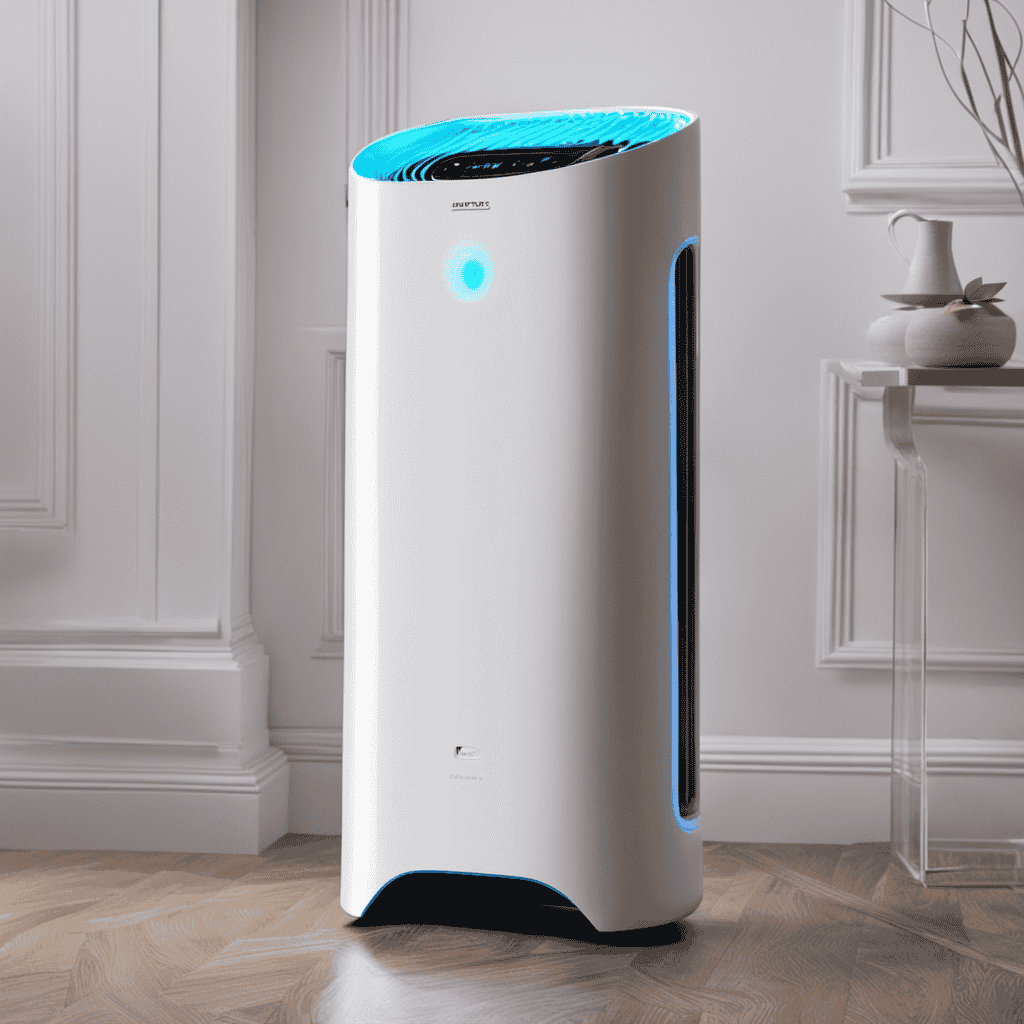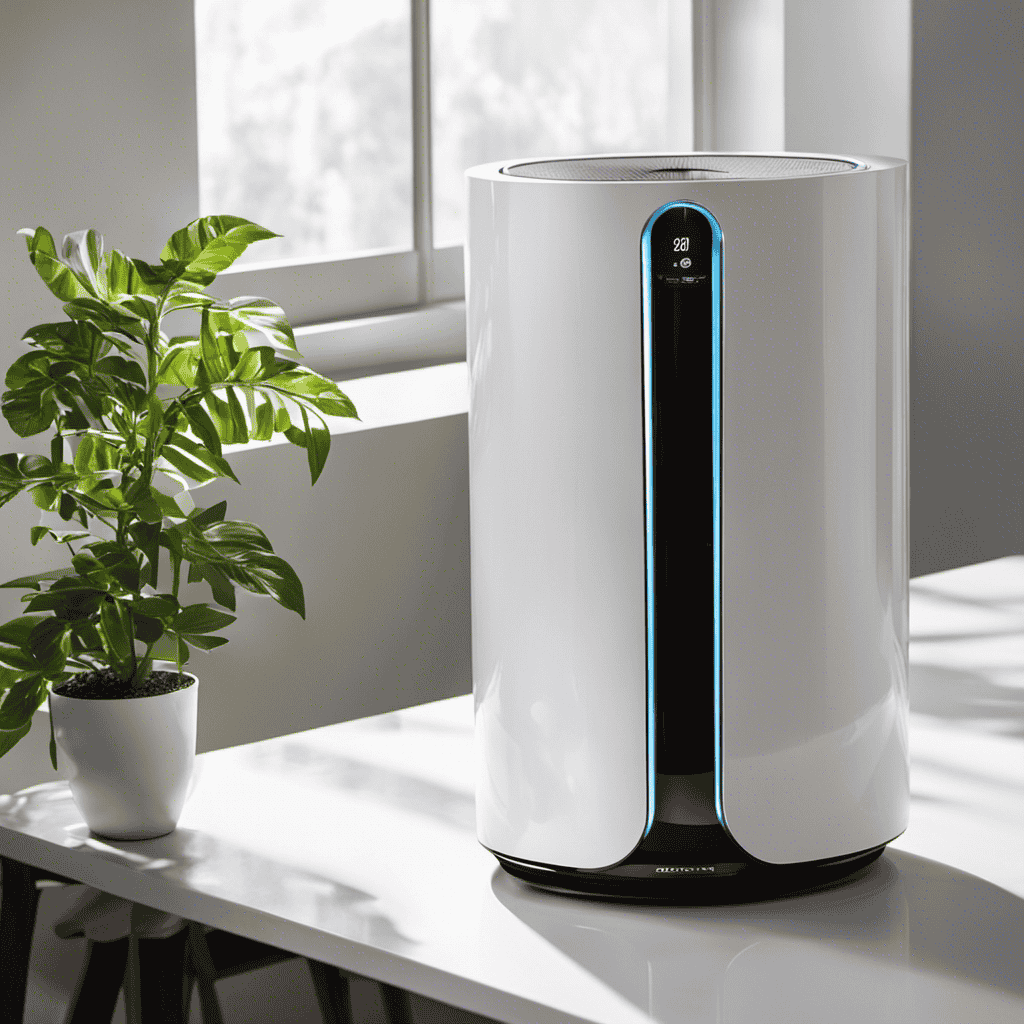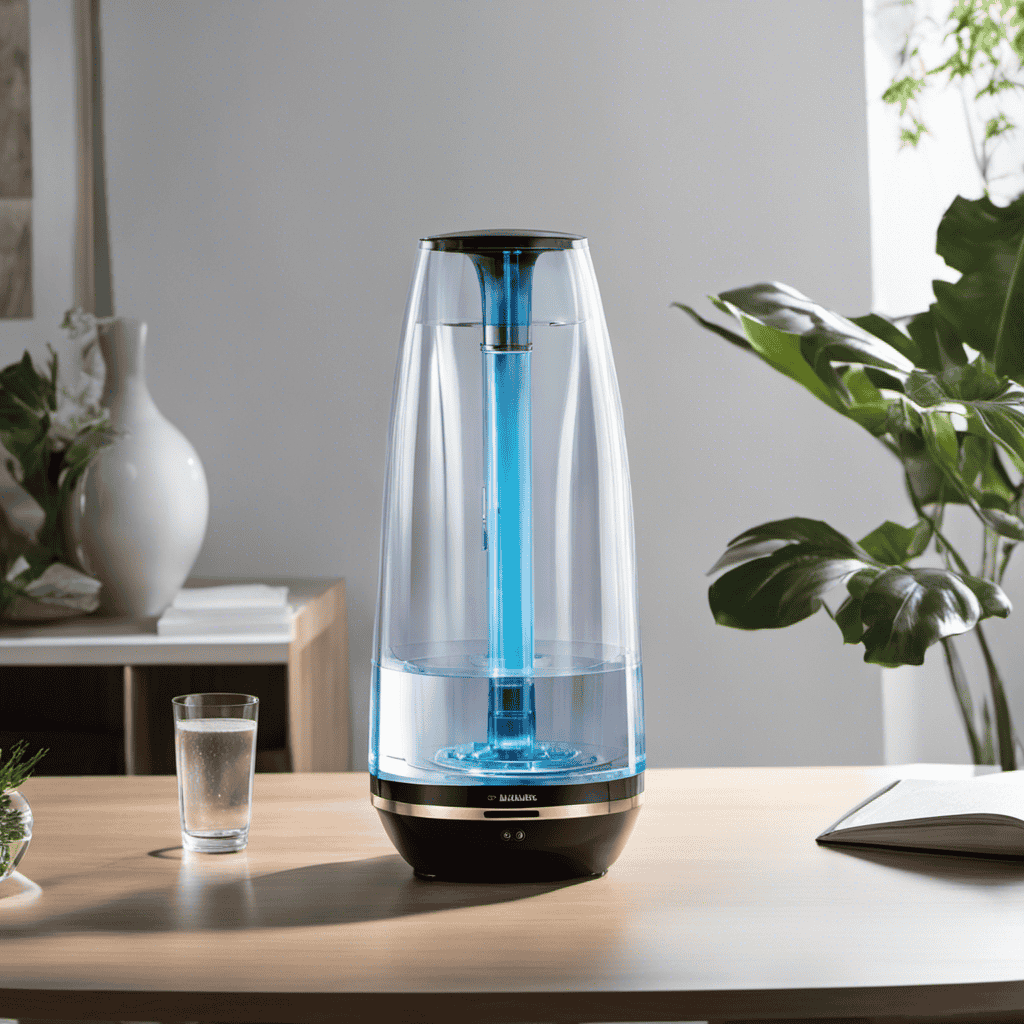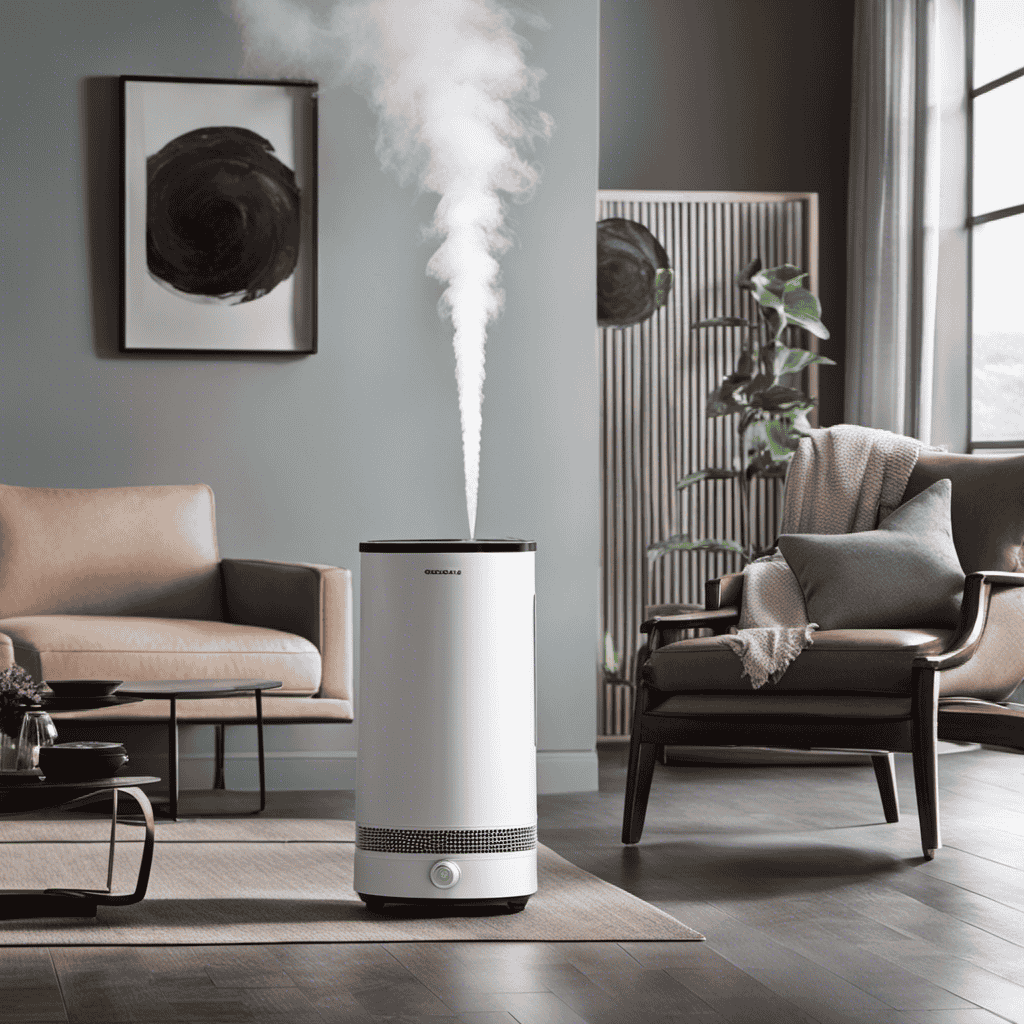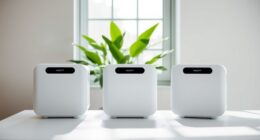Are you aware that indoor air can be up to five times more contaminated than outdoor air? This shocking reality emphasizes the significance of keeping the air in our homes clean and healthy.
One effective tool in achieving this is UV light in air purifiers. In this article, I will explore the science behind UV light and how it works to eliminate airborne pathogens.
Join me as we delve into the benefits and safety of UV light in air purification systems, debunk common myths, and learn about proper maintenance.
Key Takeaways
- UV light in air purifiers helps eliminate airborne pathogens.
- UV light can neutralize volatile organic compounds (VOCs) emitted by household products.
- UV light destroys harmful bacteria, viruses, and mold spores in the air.
- UV light breaks down volatile organic compounds (VOCs) that cause unpleasant odors.
How Does UV Light Affect Air Quality
UV light affects air quality by killing bacteria and viruses in the air. The effectiveness of UV light in killing viruses has been well-documented in scientific studies. When UV light comes into contact with these microorganisms, it damages their DNA, preventing them from replicating and causing harm.
This is especially beneficial in indoor environments where pollutants can accumulate and contribute to poor air quality. UV light also offers additional benefits in reducing indoor pollutants. It can help neutralize volatile organic compounds (VOCs), which are emitted by various household products and can lead to respiratory problems.
Understanding the Role of UV Light in Air Purification
If you want to understand how ultraviolet (UV) light works in an air purifier, it’s important to grasp its role in improving indoor air quality. UV light plays a crucial role in air purification systems by effectively eliminating various indoor pollutants.
Here are three key ways in which UV light technology benefits air purification:
-
Destruction of Microorganisms: UV light has the ability to neutralize harmful bacteria, viruses, and mold spores that may be present in the air. It disrupts their DNA structure, rendering them inactive and unable to reproduce.
-
Reduction of Odors: UV light can break down volatile organic compounds (VOCs) that are responsible for unpleasant odors in the indoor environment. It helps to eliminate odors from cooking, pets, and other sources.
-
Prevention of Airborne Allergens: UV light technology can also target and eliminate airborne allergens such as pollen, dust mites, and pet dander. This helps to reduce allergic reactions and improve overall indoor air quality.
Understanding the benefits of UV light technology in air purification systems is essential for creating a healthier and cleaner indoor environment. Now, let’s delve into the science behind UV light in air purifiers.
The Science Behind UV Light in Air Purifiers
UV light is known for its germ-killing properties, making it an effective tool in air purification. When used in air purifiers, UV light can help eliminate harmful bacteria, viruses, and other microorganisms that may be present in the air.
However, it is important to consider safety precautions when using UV light, as prolonged exposure can be harmful to humans and may require proper shielding or filtration systems to prevent any potential risks.
UV Light Kills Germs
You can see that the UV light in air purifiers effectively eliminates germs. Here are three ways in which UV light works to kill germs:
-
In hospitals, UV light is used to disinfect surfaces and air. It targets the DNA of bacteria, viruses, and other pathogens, disrupting their ability to reproduce and causing them to die off.
-
In water purification, UV light is used to kill harmful microorganisms. When water passes through a UV chamber, the light damages the DNA of bacteria, viruses, and parasites, rendering them harmless and preventing waterborne diseases.
-
UV light in air purifiers works in a similar way, sterilizing the air by destroying the genetic material of airborne germs. As air passes through the purifier, the UV light kills any bacteria, viruses, or mold spores present, ensuring cleaner and healthier air.
Air Purification Benefits
Using an air purifier can greatly improve the quality of the air I breathe. Air purification methods, such as UV light, play a crucial role in ensuring clean air.
UV light in air purifiers helps eliminate harmful microorganisms, such as bacteria and viruses, by damaging their DNA or RNA. This process, known as germicidal irradiation, effectively sterilizes the air, reducing the risk of respiratory infections.
In addition to killing germs, air purifiers also remove common indoor air pollutants like dust, pollen, pet dander, and mold spores. By eliminating these pollutants, air purifiers can reduce allergies, asthma symptoms, and respiratory irritation.
Breathing clean air has numerous benefits for my overall health and well-being, including improved sleep, increased productivity, and decreased risk of chronic respiratory diseases.
Safety Considerations With UV
When considering safety with germicidal irradiation, it is important to be aware of potential risks and take necessary precautions. UV light, commonly used in air purifiers to kill germs and bacteria, can be harmful if not used correctly. Here are three important precautions to keep in mind when using UV light for air purification:
-
Shielding: Make sure the UV light source is properly shielded to prevent direct exposure to the eyes and skin. This can be achieved by using enclosures or filters that allow UV light to pass through but block direct contact.
-
Distance: Maintain a safe distance between the UV light source and people or pets. This will minimize the risk of accidental exposure and ensure that the UV light is effective in disinfecting the air.
-
Timer and Control: Use timers or controls to limit the duration of UV light exposure. This will help prevent prolonged exposure and reduce the risk of harm.
Benefits of UV Light in Air Purification Systems
As I dive into the benefits of UV light in air purification systems, two key points stand out: its germ-killing properties and the enhanced air quality it provides.
UV light has been proven to effectively eliminate harmful bacteria, viruses, and other microorganisms in the air, helping to create a cleaner and healthier environment.
Additionally, the use of UV light in air purifiers can enhance the overall air quality by reducing the presence of allergens, odors, and other airborne contaminants.
Germ-Killing Properties of UV Light
UV light in air purifiers has the ability to kill germs and bacteria. This powerful form of light can make a significant impact on indoor air quality. Here are three ways in which UV light works to eliminate harmful microorganisms:
-
Destruction of DNA: When UV light comes into contact with bacteria and germs, it damages their DNA. This prevents them from reproducing and ultimately leads to their demise.
-
Disruption of Cellular Function: UV light disrupts the cellular function of microorganisms by targeting their enzymes and proteins. This disruption weakens their ability to survive and thrive in the air.
-
Sterilization of Air Filters: UV light can be used to sterilize the filters in air purifiers. By passing the air through UV light, any trapped bacteria or germs on the filters are effectively killed, ensuring clean and purified air.
Understanding the benefits of UV light in air purification systems is crucial for maintaining a healthy indoor environment. By harnessing the power of UV light, we can achieve enhanced air quality and reduce the presence of harmful microorganisms.
Enhanced Air Quality
Using UV light in air purification systems improves the overall quality of indoor air. Airborne contaminants are a major concern when it comes to indoor air quality, as they can have negative effects on our health and well-being. UV light has been proven to be an effective tool in eliminating these contaminants.
When UV light is used in air purifiers, it helps to destroy bacteria, viruses, mold spores, and other harmful microorganisms that may be present in the air. This not only reduces the risk of respiratory infections and allergies but also creates a healthier and cleaner environment.
UV Light: An Effective Tool for Eliminating Airborne Pathogens
UV light is an effective tool for eliminating airborne pathogens. Hospitals rely on UV light to disinfect their facilities and maintain a clean and safe environment. The powerful UV rays penetrate the DNA of bacteria, viruses, and other harmful microorganisms, damaging their genetic material and rendering them unable to replicate or cause infection.
Imagine a hospital room bathed in a soft blue glow as UV light silently works to neutralize any lingering pathogens in the air.
Similarly, UV light is also used in water purification systems to ensure safe drinking water. Picture a UV filter attached to a faucet, purifying the water as it passes through, destroying any potentially harmful bacteria or viruses.
UV light’s ability to eliminate airborne pathogens makes it an invaluable tool in promoting health and safety in various settings.
How UV Light Can Help Reduce Allergens in the Air
UV light is a powerful tool that can effectively kill germs and reduce indoor allergens. When UV light is used in air purifiers, it can help eliminate harmful bacteria, viruses, and mold spores from the air.
UV Light Kills Germs
You’ll be glad to know that the UV light in your air purifier effectively eliminates harmful germs. UV light technology has been widely recognized for its disinfection benefits, and here’s how it works:
- As the air passes through the air purifier, the UV light emits short wavelength ultraviolet rays.
- These rays penetrate the DNA of bacteria, viruses, and other microorganisms, damaging their genetic material.
- The damaged DNA prevents these germs from reproducing and renders them inactive, effectively killing them.
UV light technology in air purifiers provides a reliable and chemical-free method of disinfection. By eliminating harmful germs, it helps create a healthier and safer indoor environment.
Now, let’s explore how UV light can also play a role in reducing indoor allergens effectively.
Reducing Indoor Allergens Effectively
By using an air purifier with UV light technology, you can effectively minimize indoor allergens. UV light has been proven to be a powerful tool in reducing respiratory irritants and eliminating dust mites, which are common triggers for allergies. UV light works by breaking down the DNA of microorganisms, rendering them unable to reproduce and causing them to die off. This includes not only bacteria and viruses, but also dust mites and other allergens. The table below highlights some of the common indoor allergens that can be effectively reduced with the help of UV light technology in air purifiers:
| Indoor Allergens | Effectiveness of UV Light |
|---|---|
| Dust mites | High |
| Pollen | Moderate |
| Pet dander | Moderate |
| Mold spores | High |
| Bacteria and viruses | High |
UV Light and Its Impact on Mold and Mildew Growth
To effectively prevent mold and mildew growth, it’s important to understand the impact of UV light in air purifiers. UV light, specifically UV-C light, can play a crucial role in inhibiting the growth of mold and mildew by targeting their DNA and preventing them from reproducing. Here are three ways in which UV light contributes to mold prevention and provides health benefits:
-
Disruption of cellular functions: UV light disrupts the cellular processes of mold and mildew, inhibiting their growth and reproduction.
-
Elimination of airborne spores: UV light in air purifiers can help neutralize airborne mold spores, reducing the risk of inhalation and associated health issues.
-
Prevention of recontamination: UV light can sterilize surfaces and prevent mold spores from settling and proliferating, ensuring a cleaner and healthier environment.
Understanding the role of UV light in preventing mold and improving air quality sets the stage for exploring its effectiveness in neutralizing odors in the air.
The Role of UV Light in Neutralizing Odors in the Air
In addition to its ability to combat mold and mildew, UV light also plays a crucial role in neutralizing odors in the air. When air passes through an air purifier equipped with UV light technology, the UV rays target and break down volatile organic compounds (VOCs) that contribute to unpleasant smells. These VOCs can come from various sources such as cooking, pets, or chemicals in cleaning products. By effectively neutralizing these compounds, UV light helps to freshen the air and eliminate unwanted odors.
One of the benefits of using UV light in air purification systems is its ability to provide a continuous odor-fighting solution. Unlike traditional air fresheners or sprays that only mask odors temporarily, UV light permanently eliminates the source of the smell. Furthermore, UV light does not release any additional chemicals into the air, making it a safe and environmentally friendly option for odor removal.
Transitioning into the subsequent section, it is important to compare the effectiveness of UV light with traditional filtration methods in air purification.
UV Light Vs. Traditional Filtration: Which Is More Effective
When it comes to air purification, the effectiveness of UV light versus traditional filtration is a topic of debate.
UV light is known for its ability to neutralize harmful microorganisms, such as bacteria and viruses, by damaging their DNA.
On the other hand, traditional filtration systems use filters to physically capture particles and pollutants in the air.
Both methods have their pros and cons, and understanding their differences is crucial in determining the most suitable option for your specific needs.
UV Vs. Filters: Effectiveness
UV light is not as effective as filters when it comes to eliminating airborne particles. While UV light can help in reducing certain microorganisms, it has limitations in removing larger particles from the air. Here are three reasons why filters are more effective in this regard:
-
Filters act as a physical barrier, capturing and trapping particles as air passes through them. This helps to remove a wide range of pollutants, including dust, pollen, pet dander, and mold spores.
-
Filters can be designed with different levels of filtration efficiency, allowing for customization based on specific air quality needs. This ensures that a higher percentage of particles are removed from the air, leading to cleaner and healthier indoor environments.
-
Filters do not produce any byproducts or chemicals in the process of removing particles, making them a safer and more environmentally friendly option compared to UV light or ozone-based technologies.
Considerations for UV light and its impact on energy efficiency include the need for regular maintenance and replacement of UV bulbs, as well as the potential increase in energy consumption due to the constant operation of the UV light.
Pros and Cons: UV Vs. Filtration
The pros and cons of UV versus filtration should be carefully considered before making a decision.
UV light has been proven effective in killing bacteria, viruses, and mold spores, making it a valuable tool in air purifiers. It works by emitting short wavelength ultraviolet rays that damage the DNA of these microorganisms, preventing their reproduction.
However, UV light alone may not be sufficient to remove larger particles like dust and pet dander from the air. Filtration, on the other hand, can effectively capture these particles, improving air quality.
One concern with UV light is the production of ozone as a byproduct, which can be harmful to humans and the environment. Additionally, while UV light can help reduce allergens, it may not address the underlying causes of allergies.
Therefore, it is important to weigh the pros and cons of UV versus filtration to make an informed decision for your specific needs.
UV Light and Its Ability to Target Viruses and Bacteria
UV light can effectively target and eliminate viruses and bacteria in air purifiers. This is achieved through the use of UV-C technology, which has several advantages in terms of targeted disinfection. Here are three reasons why UV light is a powerful tool in air purification:
-
Penetration: UV-C light has the ability to penetrate the outer membrane of viruses and bacteria, reaching their DNA or RNA. This damages their genetic material, preventing them from replicating and rendering them inactive.
-
Efficiency: UV-C light can rapidly and efficiently eliminate a wide range of pathogens, including influenza, rhinovirus, and E. coli. It acts quickly, reducing the risk of contamination and providing clean and safe air.
-
Chemical-free: Unlike traditional disinfection methods that rely on chemicals, UV-C technology does not introduce any additional substances into the air. This makes it a safer and more environmentally friendly choice for air purification.
Exploring the Different Types of UV Light Technology in Air Purifiers
One advantage of using UV-C technology in air purifiers is that it can efficiently eliminate a wide range of pathogens. UV-C light, also known as germicidal UV, has been proven effective in destroying viruses, bacteria, and other microorganisms.
There are different types of UV light technologies used in air purifiers, including UV-A and UV-B, but UV-C is the most commonly used for its germicidal properties. UV-C light works by damaging the DNA and RNA of pathogens, preventing them from reproducing and causing harm.
This technology has numerous benefits, such as reducing the spread of infectious diseases, improving indoor air quality, and providing a chemical-free method of disinfection. However, it is important to note that UV-C light should be used alongside other air purification methods for optimal effectiveness.
UV Light: A Safe and Chemical-Free Solution for Air Purification
Using UV technology in your air purification system offers a safe and chemical-free solution to improve the quality of the air you breathe. UV light has a significant impact on respiratory health by reducing the presence of harmful indoor pollutants.
Here are three ways UV light helps in reducing indoor pollutants:
-
Eliminating bacteria and viruses: UV light effectively kills bacteria and viruses by damaging their DNA or RNA, preventing them from reproducing and causing infections.
-
Neutralizing mold and mildew: UV light disrupts the DNA structure of mold and mildew spores, preventing their growth and spread, which can trigger respiratory issues and allergies.
-
Reducing volatile organic compounds (VOCs): UV light breaks down volatile organic compounds, such as formaldehyde and benzene, into harmless byproducts, reducing their concentration in the air and minimizing their potential health risks.
UV Light and Its Effectiveness in Removing Volatile Organic Compounds (Vocs
To improve the air quality in your home, you’ll be pleased to know that UV technology effectively reduces the presence of volatile organic compounds (VOCs), such as formaldehyde and benzene.
UV light, specifically in air purifiers, works by breaking down these harmful compounds, thereby improving the air you breathe. VOCs are emitted from various sources, including cleaning products, paints, and furniture.
When exposed to UV light, the bonds in VOC molecules are disrupted, causing them to break down into less harmful substances. This process, known as photolysis, helps to remove VOCs from the air, leading to an overall improvement in air quality.
The Importance of Proper Maintenance for UV Light Air Purifiers
Proper maintenance is crucial for ensuring the effectiveness of UV light air purifiers. These devices rely on ultraviolet (UV) light to eliminate harmful bacteria, viruses, and other airborne contaminants. To maintain their optimal performance, here are three important steps to follow:
-
Regular cleaning: Dust and debris can accumulate on the UV light bulbs, reducing their ability to emit germicidal UV rays. Cleaning the bulbs with a soft cloth or brush will help maintain their efficiency.
-
Replacing the bulbs: Over time, UV light bulbs lose their effectiveness and may need to be replaced. It’s recommended to replace the bulbs annually or as specified by the manufacturer to ensure they are producing enough UV light to kill airborne pathogens.
-
Checking the airflow: Proper airflow is essential for UV light air purifiers to effectively sanitize the air. Regularly inspecting and cleaning the air filters, vents, and fans will ensure smooth and efficient airflow throughout the purifier.
UV Light in Air Purifiers: Debunking Common Myths
Contrary to popular belief, UV light in air purifiers doesn’t harm humans. In fact, UV light has been proven to be an effective tool in reducing indoor air pollution. There are many misconceptions surrounding the use of UV light in air purifiers, and it is important to separate fact from fiction. To help clarify the truth, let’s examine the impact of UV light on indoor air pollution:
| Misconceptions | Truths | Benefits |
|---|---|---|
| UV light in air purifiers causes skin cancer | UV light used in air purifiers is of low intensity and poses no harm to human skin | Kills bacteria and viruses |
| UV light in air purifiers emits harmful ozone | Modern air purifiers are equipped with advanced technology that minimizes ozone production | Removes allergens and mold spores |
| UV light in air purifiers is ineffective | UV light, combined with other filtration methods, can significantly improve indoor air quality | Reduces odors and volatile organic compounds |
Is it Safe to Use UV Light on Air Purifiers and What Does it Do?
UV light for air purifiers have been shown to be effective in killing airborne germs and bacteria. It helps to purify the air by breaking down pollutants and allergens. However, it is important to use it safely and follow manufacturer’s guidelines to ensure it does not cause harm.
Frequently Asked Questions
Can UV Light in Air Purifiers Completely Eliminate All Airborne Pathogens?
UV light in air purifiers has pros and cons. It can be effective in killing airborne pathogens, but it may not eliminate all of them. It’s important to consider other factors and use additional purification methods for optimal results.
How Does UV Light Technology in Air Purifiers Compare to Traditional Filtration Systems?
UV light technology in air purifiers is a game-changer! It outshines traditional filtration systems by zapping airborne pathogens with its powerful rays. Say goodbye to germs and hello to cleaner, fresher air.
Are There Any Potential Health Risks Associated With Using UV Light in Air Purifiers?
There may be potential health risks associated with using UV light in air purifiers. It is important to consider the effectiveness of UV light in eliminating harmful microorganisms while also ensuring its safety for human exposure.
Can UV Light Effectively Remove Volatile Organic Compounds (Vocs) From the Air?
UV light in air purifiers has advantages and limitations. It can effectively remove volatile organic compounds (VOCs) from the air, but its effectiveness may vary depending on factors such as the type and concentration of VOCs present.
What Are Some Common Misconceptions or Myths About UV Light in Air Purifiers?
Misconceptions about UV light in air purifiers are common. However, it offers several benefits, such as eliminating harmful microorganisms and reducing airborne allergens. Understanding these facts can help make informed decisions about air purification.
Conclusion
In conclusion, the inclusion of UV light in air purifiers is like a knight in shining armor, battling the invisible enemies that pollute our air.
This powerful tool acts as a shield, eliminating airborne pathogens and volatile organic compounds with precision and efficiency.
With proper maintenance, UV light air purifiers offer a safe and chemical-free solution to improve air quality.
So, let us welcome this radiant warrior into our homes, ensuring a breath of fresh air that is both scientifically proven and aesthetically pleasing.
